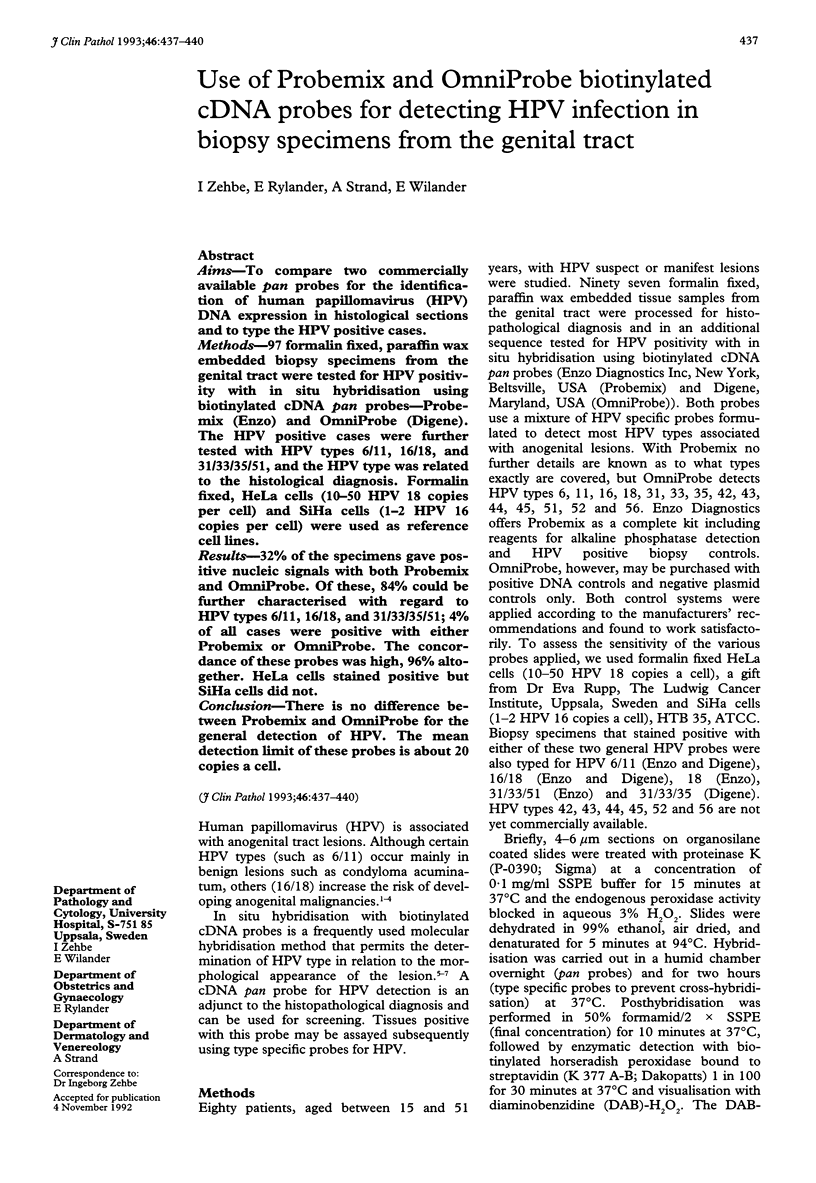Abstract
AIMS--To compare two commercially available pan probes for the identification of human papillomavirus (HPV) DNA expression in histological sections and to type the HPV positive cases. METHODS--97 formalin fixed, paraffin wax embedded biopsy specimens from the genital tract were tested for HPV positivity with in situ hybridisation using biotinylated cDNA pan probes--Probemix (Enzo) and OmniProbe (Digene). The HPV positive cases were further tested with HPV types 6/11, 16/18, and 31/33/35/51, and the HPV type was related to the histological diagnosis. Formalin fixed, HeLa cells (10-50 HPV 18 copies per cell) and SiHa cells (1-2 HPV 16 copies per cell) were used as reference cell lines. RESULTS--32% of the specimens gave positive nucleic signals with both Probemix and OmniProbe. Of these, 84% could be further characterised with regard to HPV types 6/11, 16/18, and 31/33/35/51; 4% of all cases were positive with either Probemix or OmniProbe. The concordance of these probes was high, 96% altogether. HeLa cells stained positive but SiHa cells did not. CONCLUSION--There is no difference between Probemix and OmniProbe for the general detection of HPV. The mean detection limit of these probes is about 20 copies a cell.
Full text
PDF



Images in this article
Selected References
These references are in PubMed. This may not be the complete list of references from this article.
- Nuovo G. J., Friedman D., Richart R. M. In situ hybridization analysis of human papillomavirus DNA segregation patterns in lesions of the female genital tract. Gynecol Oncol. 1990 Feb;36(2):256–262. doi: 10.1016/0090-8258(90)90184-m. [DOI] [PubMed] [Google Scholar]
- Nuovo G. J., Gallery F., MacConnell P., Becker J., Bloch W. An improved technique for the in situ detection of DNA after polymerase chain reaction amplification. Am J Pathol. 1991 Dec;139(6):1239–1244. [PMC free article] [PubMed] [Google Scholar]
- Reid R., Campion M. J. The biology and significance of human papillomavirus infections in the genital tract. Yale J Biol Med. 1988 Jul-Aug;61(4):307–325. [PMC free article] [PubMed] [Google Scholar]
- Unger E. R., Hammer M. L., Chenggis M. L. Comparison of 35S and biotin as labels for in situ hybridization: use of an HPV model system. J Histochem Cytochem. 1991 Jan;39(1):145–150. doi: 10.1177/39.1.1845759. [DOI] [PubMed] [Google Scholar]
- Warford A. In situ hybridisation: a new tool in pathology. Med Lab Sci. 1988 Oct;45(4):381–394. [PubMed] [Google Scholar]
- Wikström A., Hedblad M. A., Johansson B., Kalantari M., Syrjänen S., Lindberg M., von Krogh G. The acetic acid test in evaluation of subclinical genital papillomavirus infection: a comparative study on penoscopy, histopathology, virology and scanning electron microscopy findings. Genitourin Med. 1992 Apr;68(2):90–99. doi: 10.1136/sti.68.2.90. [DOI] [PMC free article] [PubMed] [Google Scholar]
- Zehbe I., Rylander E., Strand A., Wilander E. In situ hybridization for the detection of human papillomavirus (HPV) in gynaecological biopsies. A study of two commercial kits. Anticancer Res. 1992 Sep-Oct;12(5):1383–1388. [PubMed] [Google Scholar]





